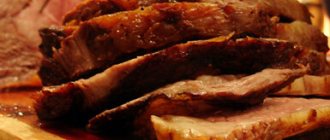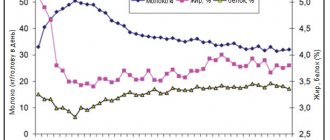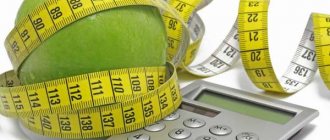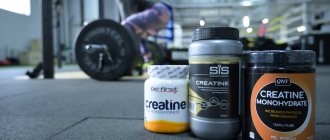Success in working on the body comes to those who know how to use the laws of metabolism (metabolism) for their own purposes. From the nutritional elements of the external environment, the body builds its own tissues and ensures their growth - this is anabolism, plastic exchange with the environment. On the other hand, the body breaks down the same nutrients (proteins, fats, carbohydrates), releasing the energy of chemical bonds.
Catabolism is the process of obtaining energy by breaking down complex molecules into simple elements, i.e. energy metabolism. The growth of muscle tissue is an anabolic process, but it is impossible without increased muscle work. Strength training is a stressful expenditure of energy, which is accompanied by the rapid breakdown of not only nutrients, but also muscle tissue. The bodybuilder’s task is to build a diet and physical activity so that the processes of anabolism (muscle growth) prevail over catabolism - the destruction of muscle tissue during training.
Stages of catabolism
From the point of view of body biology, anabolism and catabolism are two absolutely necessary processes for the body. Anabolism is the synthesis of tissues (muscle, bone, nervous, fat) from proteins, fats and carbohydrates that the body receives with nutrition.
Tissue synthesis is an energy-consuming process. The universal energy supplier for it is ATP molecules. They, in turn, are formed during catabolism - by breaking down complex substances into the simplest elements possible.
Catabolic processes occur in 3 stages:
- The preparatory stage is the digestion of food in the gastrointestinal tract or the breakdown of internal tissues (fat or muscle). Proteins are broken down into amino acids, fats are broken down into glycerol and free fatty acids, carbohydrates are broken down into glucose molecules. Catabolism at the first stage is accompanied by a small release of thermal energy.
- The oxygen-free stage takes place inside the cell, where glucose is converted into lactic acid, and amino acid and fatty acid molecules into acetyl-CoA (an intermediate catabolic enzyme). Part of the released energy is released in the form of heat, and part is accumulated in APT molecules.
- The oxygen stage is the respiration of the cell. Begins the tricarboxylic acid cycle, when carbon atoms leave organic matter, combine with oxygen and form carbon dioxide. Then, in the mitochondria of cells, the breakdown of nutrients is completed - APT molecules and water are formed.
The result of catabolism is AFT molecules, they break down and release energy in accordance with the needs of the cells.
Anabolic processes - muscle growth, for example - are impossible without catabolism and the formation of APT molecules.
Table: anabolism and catabolism - 2 sides of the same coin
| Importance for the body | Anabolism | Catabolism |
| Functions in metabolism | Tissue synthesis - plastic exchange | Energy release – energy metabolism |
| Transformations of substances | Creation of complex organic structures | Breakdown of organic substances into simple elements |
| Conversion of energy | Absorbed to form bonds in complex compounds | Released and accumulated in ATP molecules |
| AFL | Are being spent | Are formed |
Read more about what catabolism is
Catabolism is a process during which complex substances, in the form of a collection of cells, tissues, organs and other things, are broken down into simpler ones. Catabolic processes are necessarily accompanied by the formation and enrichment of energy cells in the form of ATP, which can subsequently be spent on synthesis and other vital processes, for example, movement.
The following hormones influence catabolism, or more precisely the rate of breakdown of complex substances:
- cortisol - produced in the body due to stressful situations;
- adrenaline, the concentration of which can be increased during fasting, as well as when a person experiences strong emotions;
- glucagon is a fat-burning hormone that is actively produced when the amount of carbohydrates from food is limited (in dietetics, this is possible thanks to diets with a predominant consumption of protein foods).
Why bodybuilders don't like catabolism
The goal of a bodybuilder is a muscular body with a minimum of subcutaneous fat. During anabolism, not only muscle mass increases (digestion of proteins), but also adipose tissue (digestion of fats and carbohydrates).
Video
Strength training is designed to mobilize the body to synthesize new muscle fibers, and reducing fat and carbohydrates in the diet reduces body fat. However, everything needs moderation. Excessive exercise and a strict diet create an energy deficit; the balance in metabolism shifts towards active catabolism.
The body goes into stress mode: it breaks down its own tissues to create from them the AFT molecules necessary for working cells. Energy is extracted from everywhere - from liver glycogen, adipose tissue, muscle fibers - by converting muscle protein into amino acids. The athlete fully experiences what muscle catabolism is: long-term training does not produce results, muscles do not grow, despite titanic efforts in the gym. Moreover, hard-earned muscles melt away just during training. In simple terms, the body gets rid of excess muscles, because they consume too much energy.
Active catabolism is triggered by any stress:
- nervous disorder, anxiety, excitement;
- prolonged and strong feeling of hunger;
- excessive physical activity;
- mental stress;
- lack of proper rest.
It is difficult to stop this process with willpower - the biochemistry of the processes of catabolism and anabolism is regulated by hormones.
How does anabolism occur?
After we have looked at what catabolism is, it would be appropriate to give the concept of its opposite form - anabolism. So, if catabolism is the process of breaking down polymers, then anabolism is nothing more than the synthesis of simple substances into complex compounds from which new cells and tissues of the body are built.
Anabolism ensures the growth, development and regeneration of all types of body tissues.
Assimilation metabolism also occurs in three stages:
- First, low molecular weight compounds form precursor molecules.
- In the next stage, these molecules are converted into active forms, and the cellular energy accumulated during catabolism is expended.
- The final stage includes the process of formation of the body's building materials - polymers, in the form of proteins, carbohydrates and fats.
The role of hormones in active catabolism
Metabolism is a combination of a huge number of chemical reactions, the balance between them is maintained by hormones. Having received a signal about the emerging need, the brain centers - the hypothalamus and pituitary gland - mobilize the endocrine system (adrenal glands, thyroid gland, testes and ovaries, liver) to release hormones into the blood. Some of them stimulate tissue synthesis and growth. Others block anabolic processes and trigger catabolism - the conversion of matter into energy.
Catabolism is triggered by stress hormones:
- cortisol,
- adrenalin,
- norepinephrine;
- thyroxine (T4),
- triiodothyronine (T3).
The first three are produced by the adrenal glands, the last two hormones are produced by the thyroid gland. The effect of hormones stops when stressors disappear.
Hormonal regulation of the stages of active catabolism
| №№ | Contents of the stage |
| 1 | The appearance of a stressful situation |
| 2 | Mobilization of the hypothalamic-pituitary system |
| 3 | Release of hormones by the adrenal glands: cortisol, adrenaline, norepinephrine |
| 4 | Disintegration of target tissues under the influence of chemical reactions provoked by hormones |
| 5 | Termination of stress hormones due to the elimination of the stress factor or due to depletion of the hormonal system |
A bodybuilder needs to solve two problems. During training, ensure the supply of energy through the catabolism of adipose tissue and preserve muscle tissue from decay. During the rest period, create optimal conditions for muscle anabolism.
Video
Workout: Burn Fat and Save Muscle
Proper organization of training taking into account catabolism includes several points:
- To break down fat cells, you need a strictly dosed caloric deficit - no more than 10-15% of the daily requirement. During drying with weight loss, this deficit needs to be reduced. By the 3rd week it should be 5-7%.
- To preserve muscle tissue in conditions of energy deficiency, training is necessary - then the body will understand that the muscles are “in use” and will not turn them into an energy source.
- Training regimen – 3-4 times a week for 45 minutes; You need to train often, but not for long. Overtraining is one of the main factors in muscle catabolism.
- The loads should be intense: the working weight corresponds to the ability to work with it up to 12 times during the first approach. It would be optimal to alternate the load on three muscle groups and perform it in a circle.
- Strength exercises should create a stressful situation. In the first 25–30 minutes of training, the body spends its energy reserves from liver glycogen, then hormones direct the process of extracting energy from fat depots, bypassing working muscles. The breakdown of fatty acids lasts about 20 minutes - this is the time for effective fat burning during training.
It is better not to do cardio after strength exercises - there is too great a risk of replenishing the energy deficit due to strained muscles. We dedicate a separate day to physical activity.
Meaning of sleep
If you don't get enough sleep, the neuroendocrine control of hunger and satiety is disrupted. The consequence of this is overeating and decreased tissue sensitivity to insulin, which in turn increases the risk of developing type 2 diabetes. Any of these factors leads to weight gain.
Numerous clinical studies have shown that sleep deprivation impairs the body's ability to regulate eating behavior (appetite) by reducing the concentration of leptin, the hormone that tells us we have eaten enough.
Scientists have concluded that there is a direct relationship between body mass index (BMI) and the duration and quality of sleep. Sleep deficiency corresponds to a higher BMI
If a child doesn't sleep enough, he or she is at increased risk of developing obesity. They believe that lack of sleep can lead to hormonal imbalances, which cause children to consume more food and have an overall poor diet.
Research has also shown that people who get too little sleep have elevated levels of ghrelin. Ghrelin is a hormone produced in the stomach that tells the brain that you are hungry.
Lack of sleep leads to decreased glucose tolerance and decreased insulin sensitivity by increasing the activity of the sympathetic nervous system, increasing cortisol levels, and decreasing glucose uptake in the brain.
It's not just the hormonal factors associated with lack of sleep that increase your chances of gaining excess weight. Due to lack of sleep, you are unlikely to want to exercise and play sports. Numerous experiments have shown that people who sleep little are less likely to adhere to any training program, and this is explained by the fact that they are very tired.
Try the following measures that can help you get good, restful sleep:
- Go to bed at the same time every night.
- Fill your evening hours with rest and relaxation.
- Your bedroom should be quiet, dark and a little cool.
- Try to get 7-8 hours of uninterrupted sleep every night.
- Avoid foods and drinks that contain caffeine.
- Avoid eating large meals immediately before bed. But don't go to bed hungry either.
- Don't do vigorous exercise within 4 hours of bedtime (some experts say six hours).
- On weekends, continue to go to bed and wake up on a regular schedule.
Nutrition and regime during the rest period
Muscle anabolism occurs during the rest period, when the body's energy expenditure is reduced. For muscle growth, building materials are needed - amino acids. Protein food will ensure their constant content in the blood: 1.6–2 g of protein per 1 kg of an athlete’s body weight per day is necessary and sufficient. Fats and carbohydrates during the drying period should be reduced to 1–2 g per 1 kg of weight.
Video
Food or drink rich in carbohydrates can be consumed during training and immediately after it - this will close the energy deficit and prevent catabolism of muscle tissue. While constantly maintaining a high amino acid content and avoiding fasting, we must not forget about other stress factors that trigger catabolism. Adequate sleep, balance in relationships, along with proper nutrition and reasonable training will ensure that precious muscles are not destroyed by catabolism.










